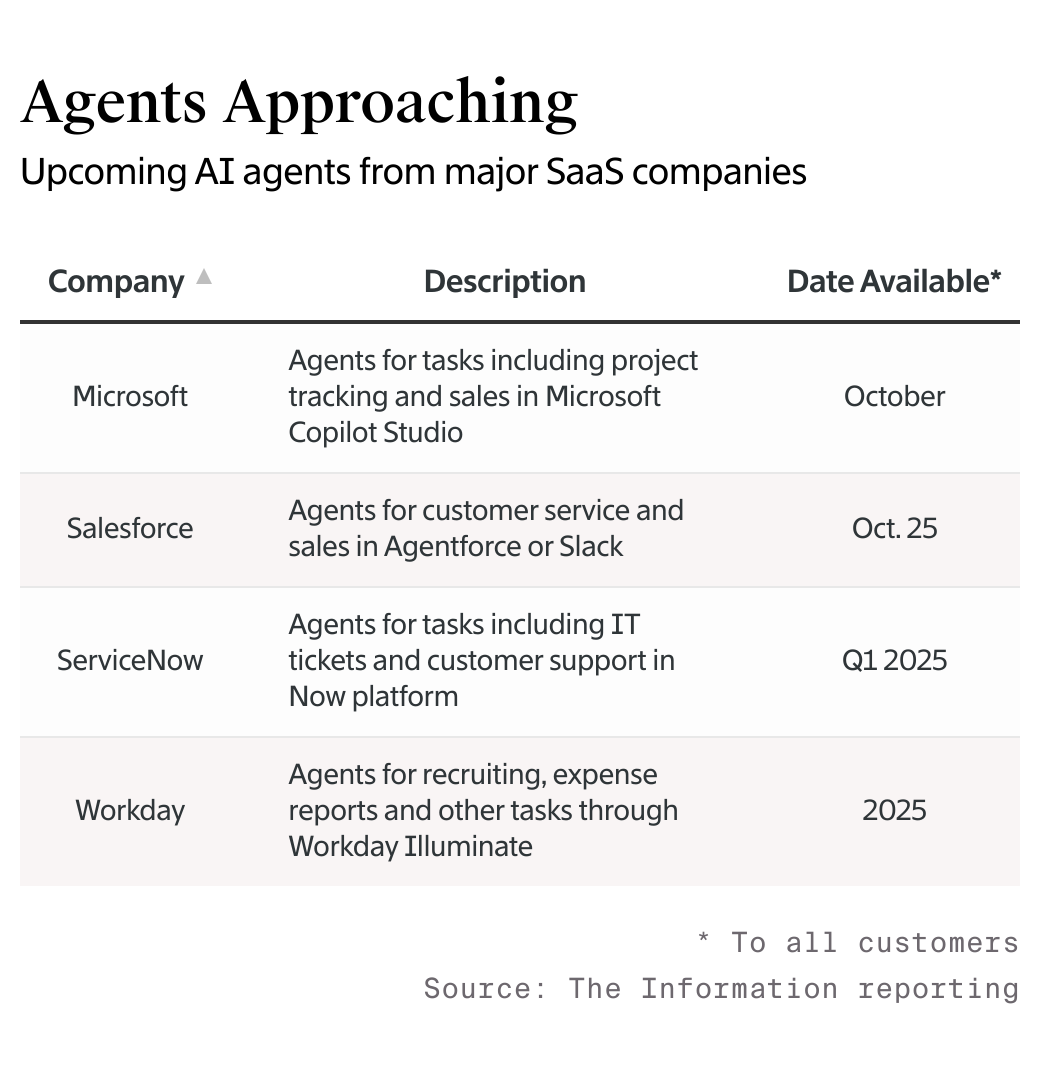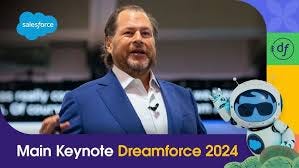AI: Long road ahead for AI Agents for enterprises and consumers. RTZ #494
...using 'AI Agents' being rolled out by Microsoft, Salesforce et al, as 'case studies' at large
The Bigger Picture, Sunday, September 29 2024
Regular readers have seen my discussions on ‘AI Smart Agents’ eventually making an impact in this AI Tech Wave for a while now. Indeed, OpenAI has described it as Level 3 in their 5 level roadmap towards AGI. They stress we’re JUST transitioning from Level 1 ‘Chatbots’ to Level 2 ‘AI Reasoners’. Their latest ‘AI Reasoning’ product rollouts around OpenAI-o1 ‘Preview and Mini’ are the next step in that direction. Ahead of GPT-5 ‘Orion’ next likely this year.
New ‘AI Agents’ on the enterprise side, and others on the consumer side, will likely have a long road to Scale. And there are a host of reasons for that potential reality. That is the ‘Bigger Picture’ I’d like to address today.
Companies from Meta to Google are focused on AI ‘chatbot’ Agents to serve mainstream consumers in the billions. Meanwhile, the enterprise market for AI Agents is seeing a ramp up this fall as well. It’s an area I’ve discussed as ‘Agentic Workflow’ software, in the broader context of the ‘slow slog’ AI cloud applications in for the business market.
There’s a renewed ramp here in recent weeks, with Microsoft’s Copilot to Salesforce’s Agentforce, and others, putting their best foot forward in the space. In particular, Microsoft’s Copilot Wave 2 led by CEO Satya Nadella, and Salesforce’s Agentforce led by founder/CEO Marc Benioff had big rollouts a few days ago with their enterprise AI Agent ambitions for the enterprise.
To set the stage, I’d highlight the Information’s “Software Firms Race to Beat OpenAI in AI Agents”:
“Even as businesses struggle to figure out how artificial intelligence chatbots can help their operations, they’re getting inundated with a new AI offering: chatbots that can independently take actions like scheduling appointments, also known as AI agents.”
“In the last month, Salesforce, Microsoft, Workday and ServiceNow—hoping to head off similar products from OpenAI—have unveiled products they said will let workers automate ordinary business tasks, such as placing an e-commerce order or scheduling a sales meeting. But the companies will have to overcome skepticism among customers before the agents can take off.”
Businesses of course are in a slow experimentation mode with AI agents, as one might expect:
“Businesses so far are wary of handing off control to an AI agent for anything important, according to Mike Knoop, co-founder of software automation company Zapier, which has been trying to develop its own agent product.”
“Basic generative AI features in Zapier’s core product, which lets customers build automated integrations between different apps, are widely used for purposes like summarizing or generating text, he said. But Zapier has seen relatively little traction for its experimental AI agents offering, Zapier Central.”
“Moreover, the agents introduced by the big companies so far appear to be limited in what they can do. Agents from Salesforce and Microsoft need to be given detailed instructions—for example, a customer has to tell the agent whether their request relates to customer service or sales, or has to give the agent the sequences of steps to carry out—according to executives at rival firms in the industry.”
Over time, with better iterations of enterprise agents, the market will be large and strategically important. So the current race has begun, with early iterations out this Fall.
“ServiceNow, Salesforce and Microsoft may believe they have little option but to jump into the agent market early. OpenAI has its own plans to launch even more capable agents that can decide for themselves how best to carry out tasks in a web browser or application, like booking travel or transferring data to a spreadsheet. OpenAI CEO Sam Altman has said OpenAI’s technology will soon let organizations automate work currently done by large swaths of employees.”
“Given OpenAI’s lead in chatbots, software firms need to get their customers to adopt the technology before the company launches its agents.”
Traditional enterprise software ‘SaaS’ (Software as a Service) companies, don’t want to wait for OpenAI to get ahead in the space.
Complexity, Reliability, and Cost are some of the early AI Agent adoption issues raised by businesses large and small:
“The focus on agents follows a mixed reaction to software firms’ push to sell AI chatbots or copilots, often used to answer employees’ questions about internal documents and processes. The much-hyped chatbots—including Microsoft’s Copilot, the enterprise market leader—have yet to take off thanks to performance and cost issues.”
And the competitive sniping has already begun:
“Salesforce CEO Marc Benioff, for one, has been vocal about the need to move on from copilots. “We don’t see how that copilot world is going to get us to the real vision of artificial intelligence,” Benioff said in his opening remarks at Salesforce’s annual Dreamforce conference earlier this month.”
The focus near-term is on the low-hanging fruit in the Enterprise:
“The new agents are meant to do more—mostly because they can take actions in addition to answering questions. Salesforce, Microsoft and ServiceNow say they can operate with little to no supervision and replace work done by human employees, like helping a customer change an e-commerce order or emailing a potential customer to set up a sales call.”
But it’ll likely be a year or two before the companies find their ‘product-market-fit’ with business AI Agents, or longer:
“Salesforce is “years away from having what they talked about last week being permeated across their customer base in a meaningful way,” said Evan Osheroff, a managing director at investment bank Jefferies who specializes in enterprise software.”
If one looks at the chart at the top of this post, it’s likely that both the Level 2 AI ‘Reasoning’ and Level 3 ‘Agents’ part of the road map are likely to take AT LEAST a couple of years EACH, if not more, to get to even a ‘barely reliable’ level of reliability and reproducibility. And likely in sequence and not in parallel.
AI researchers at the top companies large and small know what they have to do. Especially the big ones beyond OpenAI like Google, Anthropic and others globally. They have to scale the basic LLMs, SLMs and MLLMs (Large, Small and Multimodal Language Models) as we’ve been discussing for months.
For both training and inference of the models. At least through OpenAI GPT 5, 6 and beyond. Each of those are at least a couple of years apart. Same with the generational improvements from Google, Anthropic and the other global LLM AI companies.
BUT THEN, in ADDITION, they ALSO have to concurrently apply more AI Scaling to the reinforcement learning based on the ‘Chain of Thought’ and related set of technologies. It’s what OpenAI showed off with OpenAI o1 (‘Strawberry), after at least a couple of years of hard research work on these and related AI innovations. The productization engineering is just now getting started as the OpenAI gets ready for the road ahead.
And for a majority of AI reasoning and agent work by the industry at large, it will also take a ton of heuristic and hybrid traditional software tweaking and programming. To get to even the front doors of useful and dependable ‘AI Reasoning’ and ‘AI Agents’. Companies along with OpenAI like Google, Anthropic, Elon’s xAI Grok and dozens of other major LLM AI companies, are all likely focused on these parallel and sequential tasks from Level 1 to Level 3.
Note that as I’ve often referenced, just getting self driving cars from Level 1 over a decade ago to Level 2 today (including Tesla), has taken over a decade and billions of global AI investments.
Foundation AI Robotics that I’ve discussed in humanoid and other robots, will also take longer than expected, with Moravec’s Paradox added to the mix,
The AI industry at large has learned a lot from those efforts, potentially curtailing the time frames needed ahead. But it’s likely to a relative deliberate pace for LLM AI as well, since a lot of tech has to be researched, developed, built, and then productized at scale. And deal with the constant, long-tail of AI ‘Edge Cases’.
Which means that the industry will need EVEN MORE AI ‘Table Stakes’ Compute, Data center and Power infrastructure than is currently being planned. And likely even more if in the interim customer adoption takes off even at a respectable linear rate. That’s because of the ‘Variable Cost’ nature of today’s AI software I’ve discussed.
So the current hundreds of billions are a mere downpayment on the beginning of beginning to make progress to Levels 2 and 3. It’s likely going to be a long road on thus ‘Intelligence Age’ journey articulated by OpenAI’s Sam Altman.
And the investments will be out of sync with the financial rewards. It will generally mean more supply constraints for the AI infrastructure providers from Nvidia to many others (Boxes 1 through 5 in the AI Tech Stack below).
But the industry WILL make progress towards far better AI Agents than are being rolled out today. And everything discussed above applies to BOTH consumer and enterprise AI Reasoning and Agents.
So the really useful and viable AI Agents on the enterprise side will likely start with Microsoft Copilot 4 or 5, and Salesforce Agentforce in 2026 and beyond. But we will inch our way there. And businesses will continue to experiment with the annual iterations, with varying levels of utility and adoption.
Overall, AI Smart Agents are too big an opportunity in this AI Tech Wave to ignore, both on the business and consumer fronts. However long it takes.
That is the ‘Bigger Picture’ right now on ‘AI Agents’, and the race is on. Stay tuned.
(NOTE: The discussions here are for information purposes only, and not meant as investment advice at any time. Thanks for joining us here)














Even if it takes a couple years minimum to get from one level to the next, isn’t that a massive technological achievement? It took the internet nearly two decades to get high speed internet fast enough to stream HD movies at home.